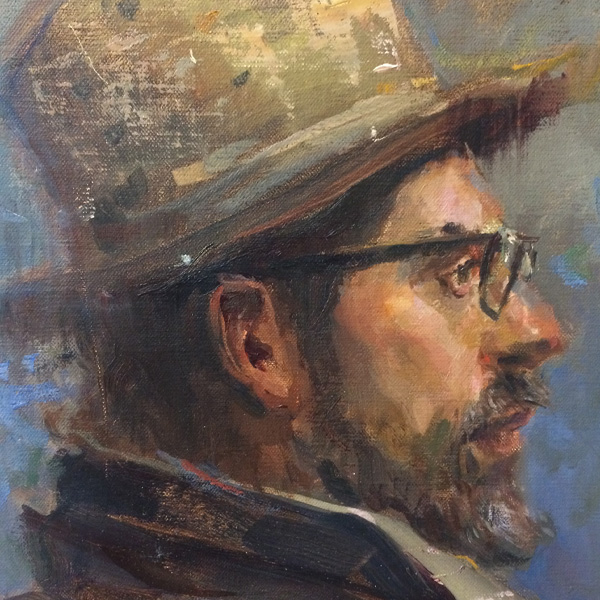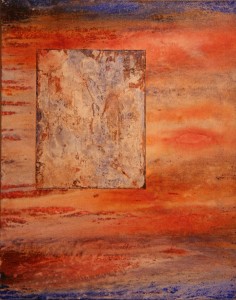Dear Artist,
Artists need to be constantly on the prowl for ways to make their work more visually exciting. Art needs magic bullets beyond mere subject matter. Fact is, perfectly dull subjects can be made more interesting with a little extra thought and effort. You may already be applying some of these ideas, but if my request seems more like a tough order, perhaps these exercises will be all the more important for you.
Take a small card or canvas and divide it into six areas. The first on my list is an easy one.
1. Paint a smooth gradation from warm to cool or cool to warm.
2. Using a red, a yellow and a blue, or a green, a purple and an orange, paint three equal-intensity colours side by side. When you half close your eyes, they should all be about the same value.
3. Without showing any form, paint something that appears to protrude from something that appears to recede.
4. Paint some patches of tone or colour in alternation along a partly disclosed curved line and try to “hold” the line by implying it. Still with me?
5. Paint a “transformer” — that is, some subject or motif that looks like or becomes something else. Think of a praying mantis that could be a truck, or an owl that could be Uncle Fred.
6. Paint a simple motif or subject from life, then cover part of it up by further painting up to and past it so that the motif or subject is now only partly disclosed.
Always learning, always questioning, we see exercises like these as experiments — even when they come from some dude in a computer. “The true method of knowledge is experiment,” said William Blake. “Life,” said Ray Bradbury, “is trying things to see if they work.”
Exercises like these have the distinct tendency to wander into your regular work and add mystery, interest and appeal. Displacing the commonplace, they show your artist’s hand.
Best regards,
Robert
PS: “All life is an experiment. The more experiments you make the better.” (Ralph Waldo Emerson)
Esoterica: Of course you can do these sorts of experiments in and about your regular work. Those you make up yourself will be the most valuable. Those who search, find. The idea is to make the business of exercise and experimentation habitual. Just as a tinkerer can go on and on in his shop, missing meals and important appointments, the artist stays glued to the unfolding of experiments. I call it magic — you can call it anything you want. You may not be able to put your finger on exactly what the magic is, nor will you be able to put it into words, but magic will be in the air.
This letter was originally published as “Six exercises in magic” on September 17, 2010.
Sara Genn: New Alphabet opens this coming Thursday, September 12th, 2019 at Dimmitt Contemporary Art, 3637 West Alabama Street, Houston.
The Letters: Vol. 1 and 2, narrated by Dave Genn, are available for download on Amazon, here. Proceeds of sales contribute to the production of The Painter’s Keys.
Art is magic… But how is it magic? In its metaphysical development? Or does some final transformation culminate in a magic reality? In truth, the latter is impossible without the former. If creation is not magic, the outcome cannot be magic. (Hans Hofmann)
Featured Workshop
This workshop is foundational for all figurative painters, providing a tangible step-by-step system on how to create realistic skin tones, and apply them with ease to the portrait.
Emphasis is placed upon ‘tiling’ colours next to each other (darks, half-tones, lights) in a mosaic-like manner, and then refining edges to depict lifelike 3-dimensional form.
By the weekend’s end, you will have a finished portrait, and newfound confidence in adjusting colour while applying paint, all in one stroke!
For more info, or to register, please visit our website: https://www.canvasmethod.ca/classes/fall-courses
Featured Artist
Painting is my passion and joy. My process is intuitive, though informed by good composition and design principles. I paint what I remember, or think about, or feel, or just what comes off my hands to the brush to the canvas. Texture and color are of primary importance to me. I typically choose my support, texture it, select my palette, and go. There is nothing more satisfying to me than watching paint run and move. I love the surprises. I experiment and learn constantly. It is a remarkable journey. One I am pleased to share with you.










17 Comments
Interesting – if I understood it but even the ‘easy’ first step completely flummoxed me! I’m an instinctive painter and love to play with the colours and paint, letting them guide me and seeing what works – it usually does but not always, of course, so having the short cuts that I guess Robert’s exercises above provide would be interesting and I’m a great believer in magic so I’d love to have a go. Sara please can you re-print this with your own illustrations to show what your father meant? I’ll be really grateful as I’m sure will anyone else who doesn’t understand the written words without a little illustrative help.
Fingers crossed you won’t mind.
Many blessings, Jenny
I agree with Jenny! I’d love to try these, but need some
visual assistance.
I’m also somewhat baffled by this article. Examples of the six items would be a great way of showing what is actually meant by what Robert writes.
I agree with Jenny and ERG. What a gift that would be to all of us! Hope you can find the time.
I don’t understand even the first step: Paint a smooth gradation from warm to cool or cool to warm. Want to finish this.Need help
I’d be interested in seeing an example of the transformer concept. Altogether, these are compelling exercises. Good stuff.
Love thi idea and the exercise, but would also have really liked to see all the examples on a note card. But, I can also appreciate that you don’t want us repeating what you’ve done, but should exercise our creativity in coming up with our own. Thank you for these letters.
In viewing the Rainbow girl with the colours from the rainbow in her dress and umbrella and the painting of Low tide, I can see the connection. Beautiful tones. Thank you for this exercise I shall work on it.
Yes, the rainbow girl is true Magic, with all the variations of blues.
I am surprised that so many found this something they would want an example of- in order to try doing it first?! I certainly feel sensations of visual outcomes, while reading the exercises described. The idea to me is to try to get a surprise or transformation of forms, as you struggle to create your own interpretation of these …not have someone illustrate them for you??…Each stab at one idea, is in itself, from your own effort– and will bring something never before created by you–a mystery and a bit of original magic, possibly…even if you did not entirely know how it should look! I am not a good writer, granted, but think one must feel their way thru the descriptions ….and enjoy the process….and maybe something new to you will happen…Surprise!
I’m with you here. The whole point is to experiment and let your visual sense guide you along. What’s the point of copying?
Oh goodness – I agree totally with the mystery and magic and I almost always let the paint and the colours and the wonder of it all be my guide. And usually it works just fine! But I have huge respect for Robert Genn and thought I’d give the exercises a go. But didn’t know what the words meant. (Head, you see – not heart). Then I read the comments about his Rainbow Girl and had a look and realised – Ah – Simple. Blues and aquas cold, pinks, oranges, some mauves warm. Got it! And knew and do it already. You see, I assumed his exercise was a zillion times more complicated than it is! But way too scared to do the others. I’ll just keep painting my way I guess. Still hoping Sara will help out though, especially as I’m not the only one who found them confusing. To all those who understood – well done you, but hey, we’re all different and learn in different ways, don’t we?
Yes please I agree with all the comments above. I would love to have a go at this exercise but I need visual aids!
Sara, this letter was a fascinating experience for me! I never picked up a brush, but the way your integration of your dad’s art exercised my imagination to find those six assignments fulfilled was marvelous.
I just had to say thank you.
What exquisite paintings! Magic works!
I do see the value in coming up with our own small interpretations of these – dig deep!
However, I would also (as so many other replies above) to see how others interpret the exercises to learn and expand even further…please Sara! Maybe we could somehow upload our own so others can see on this area or another area on the site?
Thanks always for the letters
Thank you Sara – thank you everyone for all the lovely posts about this. However we learn, whatever our individual ways of painting – we are of one blood, we artists. It’s the joy of painting that’s the magic. Challenge is good sometimes, but let’s not lose sight of the joy of our creativity and the bliss of colour and paint when we free ourselves to let them flow. Love to you all, Jenny